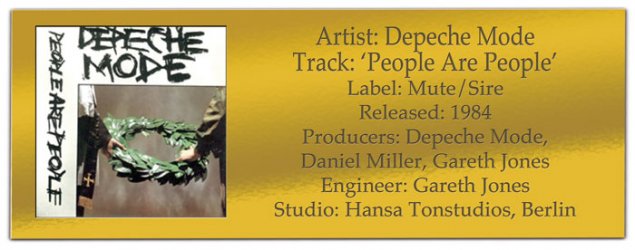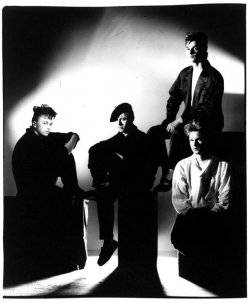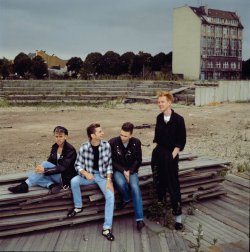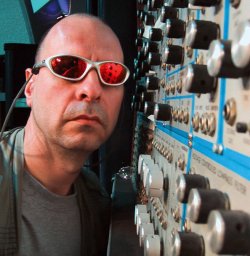Classic Tracks: Depeche Mode 'People Are People' (Sound On Sound, 2007)
CLASSIC TRACKS: Depeche Mode 'People Are People'
Producers: Depeche Mode, Daniel Miller, Gareth Jones • Engineer: Gareth Jones
Published February 2007
By Richard Buskin

'People Are People' perfectly combined Depeche Mode's love of pop music and experimentalism, and gave them their first US hit single.
Having evolved from new romantic to electro-pop, and survived the departure of co-founder and chief composer Vince Clarke (the keyboardist/composer formed Yazoo with singer Alison Moyet shortly after the UK-top-ten success of the single 'Just Can't Get Enough'), Depeche Mode began to hit their stride on the all-synth outfit's third album, Construction Time Again. Released in 1983, this signalled a growing sophistication in terms of Martin Gore's introspective songwriting and the arrangements of fellow keyboard player Alan Wilder, alongside the contributions of keyboardist Andrew Fletcher and vocalist David Gahan.
Gareth Jones engineered this record, and the following year he fulfilled the same role on Some Great Reward whilst also co-producing it with the band and Mute Records A&R exec Daniel Miller. The Basildon quartet's industrial-fusion apotheosis, this featured the classic dance track 'Master and Servant', as well as 'People Are People' which scored big on both sides of the Atlantic following its recording and release as a stand-alone single in April 1984.
"That song was kind of a stepping stone between Construction Time Again and Some Great Reward," Jones explains. "It signalled the band's transition towards more industrial sounds."
Beginnings
Basing himself in London after having grown up in the small Midlands market town of Evesham, Worcestershire, Gareth Jones gained his formal training at BBC Radio during the late-'70s. In his spare time, he also worked at a small eight-track studio named Pathway, in Stoke Newington, North London, and it was after moving there on a full-time basis in 1979 that he engineered Metamatic, the minimalist synth-pop solo debut of singer/keyboardist and former Ultravox frontman John Foxx.

Depeche Mode 1984. Left to right: Alan Wilder, Martin Gore, Dave Gahan and Andy Fletcher.
This album, as well as Foxx's 1981 follow-up, The Garden, subsequently brought Jones to the attention of Daniel Miller and Depeche Mode, and Construction Time Again was actually recorded at John Foxx's newly built London studio, also named The Garden and now part of the Miloco complex.
"We felt that a lot of what we were doing was defining new sonic territories," says Jones with regard to the Depeche Mode perspective when he began working with the band. "Even on Construction Time, one of the things I brought to the table was to put the synthesizers through guitar amps. That wasn't being done very much back then — as far as we were concerned, we were the first people to do it — and that was part of the gradual darkening of the Depeche Mode sound. The band members wanted to experiment and they wanted to grow, and they were fed up with their synth-pop image. They didn't feel it did justice to what they wanted to express. They clearly wanted to go a long way, and at that time they were starting out on the journey towards Violator and Songs of Faith and Devotion."
Embracing Samplers
Having mixed Construction Time Again at Hansa Tonstudios in Berlin due to the appeal of that city, the esteemed reputation of the then state-of-the-art facility and the favourable exchange rate between the pound and the Deutschmark, Depeche Mode and Daniel Miller also opted to use Hansa for the recording and mix of 'People Are People'. The studio was equipped with a custom 'Hansa Blue' 48-channel SSL 4000E Series console and 24-track Studer A800 tape machine. The band brought their own BBC Micro computer-based sequencer along, and Miller's own Synclavier was used to sample and edit audio while also serving as a great additive synth.
"That song was a lot about sampling and the room," says Gareth Jones. "The monophonic Synclavier was a big part of the sound — we didn't have the polyphonic sampler until the fifth album [1986's Black Celebration] — and we also had an Emulator II and my own AMS. These were used all the time, and since only the Synclavier stored samples, a lot of what we did was recorded onto tape; track by track.
"Martin made a demo for 'People Are People' — it was also the first time the band had done a pre-production session — and this had one ambient sound that he'd recorded with a Walkman on an airplane; a bit of laughter and noise. He looped this up on the demo, and we decided to somehow recreate that sound, but it was impossible to recreate because it was a 'found sound', full of texture and rhythm, so we ended up using what was on the demo. Nobody thinks anything of that now — found sounds are used all the time — but back then it was a bit of a breakthrough for us. The demos were all very lo-fi, recorded on four-track or whatever, yet somehow a tiny snippet of this sound still existed in the Emulator and it became a big part of the chorus. I remember that very clearly, because there was a moment's confusion when we thought, 'How are we going to recreate that?' and then suddenly we realised we didn't need to recreate it, we'd just use it.
"One of the big things we were using samplers for at that time was to sample the world and make our own melodies and rhythms out of it. In my work with Depeche and others, I've never been that interested in using samplers to recreate conventional instruments. Instead, when the sampler came out it was like opening a door of perception. We could sample almost sound and turn it into a rhythm or melody, or even use the intrinsic rhythm within a sound — during that period there were lots of sounds on Depeche Mode records (although not on 'People Are People') that consisted of spinning saucepan lids, things falling downstairs, ping-pong balls bouncing, and loads of things with inherent rhythm that we twisted and warped into Martin's songs. The fragment of sound from the aircraft cabin was part of that."
Of particular note in this regard was 'Pipeline', which appeared on the Construction Time Again album, featuring drumsticks and hammers beating steel plates, pipes and various other metal objects, as recorded at a disused train station in Shoreditch, East London, with a cassette machine and assorted mics. The story of such sounds being captured by Jones at a German junkyard is apocryphal, yet it does have some basis in reality, and some of the aformentioned Shoreditch tapes were also utilised for the jerky rhythm on 'People Are People'.
"I was working with Einsturzende Neubaten, who in the early days made a lot of art music that featured the sound of banging metal," he says, referring to the German band whose name means Collapsing New Buildings. "I didn't use their sounds on 'People Are People', but certainly I embraced their aesthetic. It was a very fertile time, because I was introducing Einsturzende Neubaten to sequencers and we were using sampled metal with Depeche Mode, and having had that one expedition into the industrial wilderness with hammers and sticks we were then taking sounds from anywhere. Of course, as reflected later in the 'People Are People' video that was shot on HMS Belfast, we felt that banging metal was a very brutal and intense noise, and so a lot of that was built into the song."
CLASSIC TRACKS: Depeche Mode 'People Are People'
Producers: Depeche Mode, Daniel Miller, Gareth Jones • Engineer: Gareth Jones
Published February 2007
By Richard Buskin

'People Are People' perfectly combined Depeche Mode's love of pop music and experimentalism, and gave them their first US hit single.
Having evolved from new romantic to electro-pop, and survived the departure of co-founder and chief composer Vince Clarke (the keyboardist/composer formed Yazoo with singer Alison Moyet shortly after the UK-top-ten success of the single 'Just Can't Get Enough'), Depeche Mode began to hit their stride on the all-synth outfit's third album, Construction Time Again. Released in 1983, this signalled a growing sophistication in terms of Martin Gore's introspective songwriting and the arrangements of fellow keyboard player Alan Wilder, alongside the contributions of keyboardist Andrew Fletcher and vocalist David Gahan.
Gareth Jones engineered this record, and the following year he fulfilled the same role on Some Great Reward whilst also co-producing it with the band and Mute Records A&R exec Daniel Miller. The Basildon quartet's industrial-fusion apotheosis, this featured the classic dance track 'Master and Servant', as well as 'People Are People' which scored big on both sides of the Atlantic following its recording and release as a stand-alone single in April 1984.
"That song was kind of a stepping stone between Construction Time Again and Some Great Reward," Jones explains. "It signalled the band's transition towards more industrial sounds."
Beginnings
Basing himself in London after having grown up in the small Midlands market town of Evesham, Worcestershire, Gareth Jones gained his formal training at BBC Radio during the late-'70s. In his spare time, he also worked at a small eight-track studio named Pathway, in Stoke Newington, North London, and it was after moving there on a full-time basis in 1979 that he engineered Metamatic, the minimalist synth-pop solo debut of singer/keyboardist and former Ultravox frontman John Foxx.

Depeche Mode 1984. Left to right: Alan Wilder, Martin Gore, Dave Gahan and Andy Fletcher.
This album, as well as Foxx's 1981 follow-up, The Garden, subsequently brought Jones to the attention of Daniel Miller and Depeche Mode, and Construction Time Again was actually recorded at John Foxx's newly built London studio, also named The Garden and now part of the Miloco complex.
"We felt that a lot of what we were doing was defining new sonic territories," says Jones with regard to the Depeche Mode perspective when he began working with the band. "Even on Construction Time, one of the things I brought to the table was to put the synthesizers through guitar amps. That wasn't being done very much back then — as far as we were concerned, we were the first people to do it — and that was part of the gradual darkening of the Depeche Mode sound. The band members wanted to experiment and they wanted to grow, and they were fed up with their synth-pop image. They didn't feel it did justice to what they wanted to express. They clearly wanted to go a long way, and at that time they were starting out on the journey towards Violator and Songs of Faith and Devotion."
Embracing Samplers
Having mixed Construction Time Again at Hansa Tonstudios in Berlin due to the appeal of that city, the esteemed reputation of the then state-of-the-art facility and the favourable exchange rate between the pound and the Deutschmark, Depeche Mode and Daniel Miller also opted to use Hansa for the recording and mix of 'People Are People'. The studio was equipped with a custom 'Hansa Blue' 48-channel SSL 4000E Series console and 24-track Studer A800 tape machine. The band brought their own BBC Micro computer-based sequencer along, and Miller's own Synclavier was used to sample and edit audio while also serving as a great additive synth.
"That song was a lot about sampling and the room," says Gareth Jones. "The monophonic Synclavier was a big part of the sound — we didn't have the polyphonic sampler until the fifth album [1986's Black Celebration] — and we also had an Emulator II and my own AMS. These were used all the time, and since only the Synclavier stored samples, a lot of what we did was recorded onto tape; track by track.
"Martin made a demo for 'People Are People' — it was also the first time the band had done a pre-production session — and this had one ambient sound that he'd recorded with a Walkman on an airplane; a bit of laughter and noise. He looped this up on the demo, and we decided to somehow recreate that sound, but it was impossible to recreate because it was a 'found sound', full of texture and rhythm, so we ended up using what was on the demo. Nobody thinks anything of that now — found sounds are used all the time — but back then it was a bit of a breakthrough for us. The demos were all very lo-fi, recorded on four-track or whatever, yet somehow a tiny snippet of this sound still existed in the Emulator and it became a big part of the chorus. I remember that very clearly, because there was a moment's confusion when we thought, 'How are we going to recreate that?' and then suddenly we realised we didn't need to recreate it, we'd just use it.
"One of the big things we were using samplers for at that time was to sample the world and make our own melodies and rhythms out of it. In my work with Depeche and others, I've never been that interested in using samplers to recreate conventional instruments. Instead, when the sampler came out it was like opening a door of perception. We could sample almost sound and turn it into a rhythm or melody, or even use the intrinsic rhythm within a sound — during that period there were lots of sounds on Depeche Mode records (although not on 'People Are People') that consisted of spinning saucepan lids, things falling downstairs, ping-pong balls bouncing, and loads of things with inherent rhythm that we twisted and warped into Martin's songs. The fragment of sound from the aircraft cabin was part of that."
Of particular note in this regard was 'Pipeline', which appeared on the Construction Time Again album, featuring drumsticks and hammers beating steel plates, pipes and various other metal objects, as recorded at a disused train station in Shoreditch, East London, with a cassette machine and assorted mics. The story of such sounds being captured by Jones at a German junkyard is apocryphal, yet it does have some basis in reality, and some of the aformentioned Shoreditch tapes were also utilised for the jerky rhythm on 'People Are People'.
"I was working with Einsturzende Neubaten, who in the early days made a lot of art music that featured the sound of banging metal," he says, referring to the German band whose name means Collapsing New Buildings. "I didn't use their sounds on 'People Are People', but certainly I embraced their aesthetic. It was a very fertile time, because I was introducing Einsturzende Neubaten to sequencers and we were using sampled metal with Depeche Mode, and having had that one expedition into the industrial wilderness with hammers and sticks we were then taking sounds from anywhere. Of course, as reflected later in the 'People Are People' video that was shot on HMS Belfast, we felt that banging metal was a very brutal and intense noise, and so a lot of that was built into the song."


